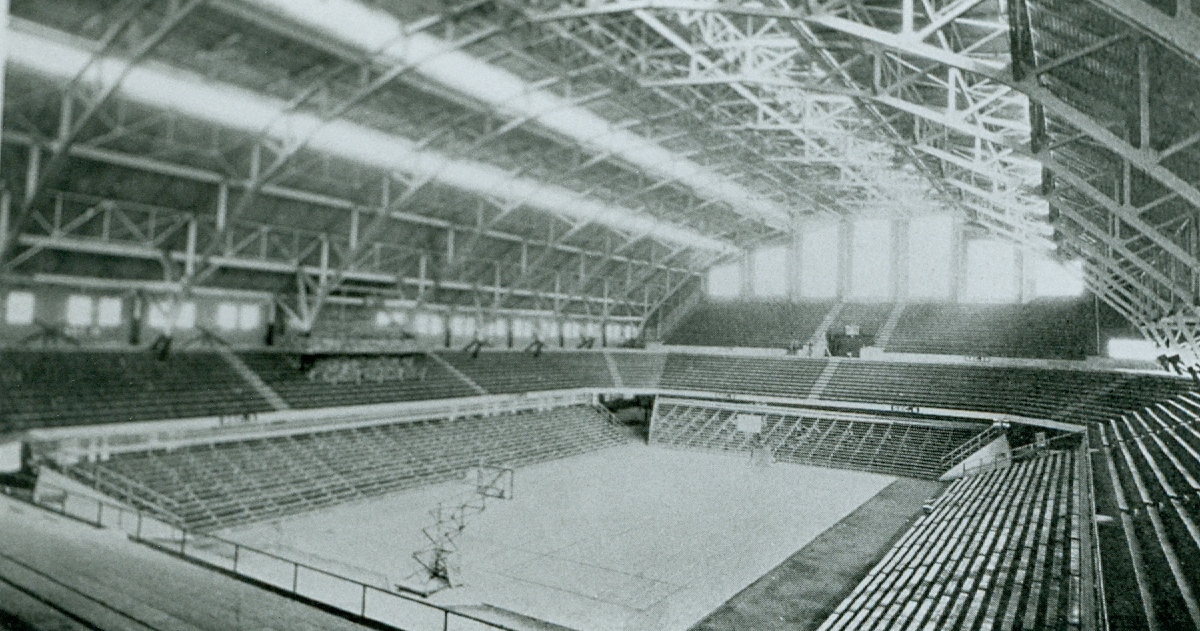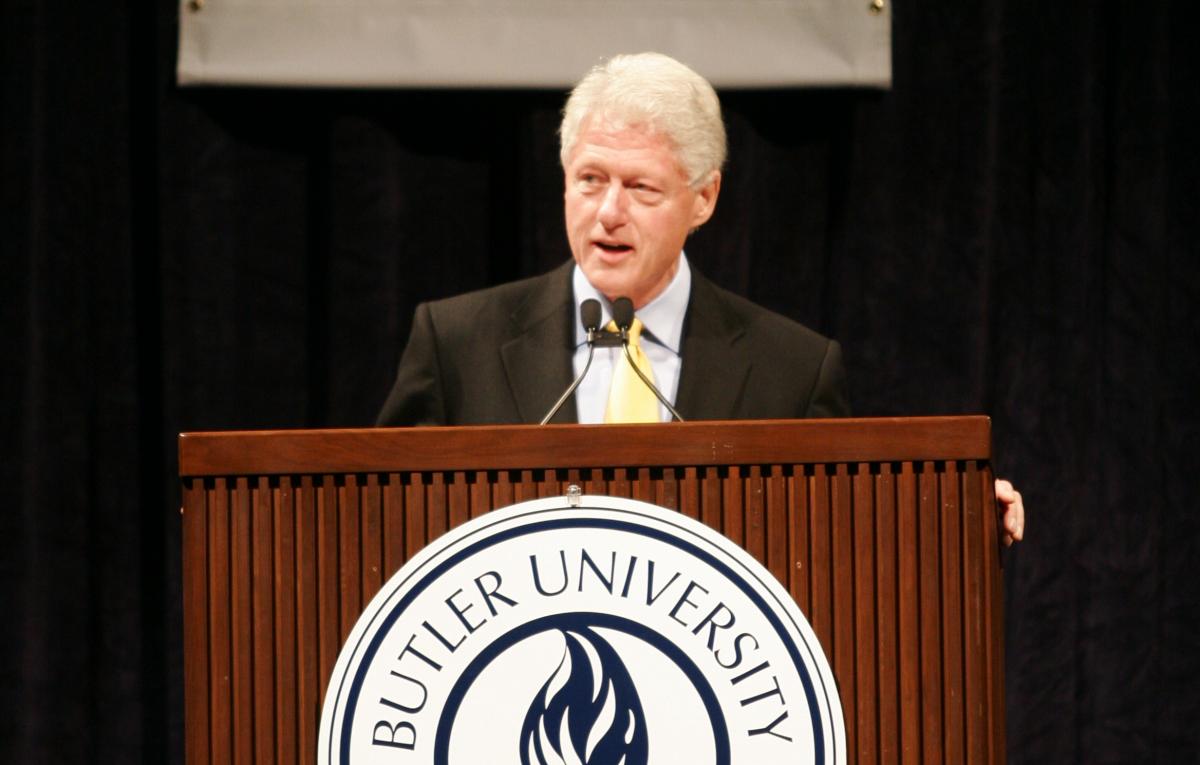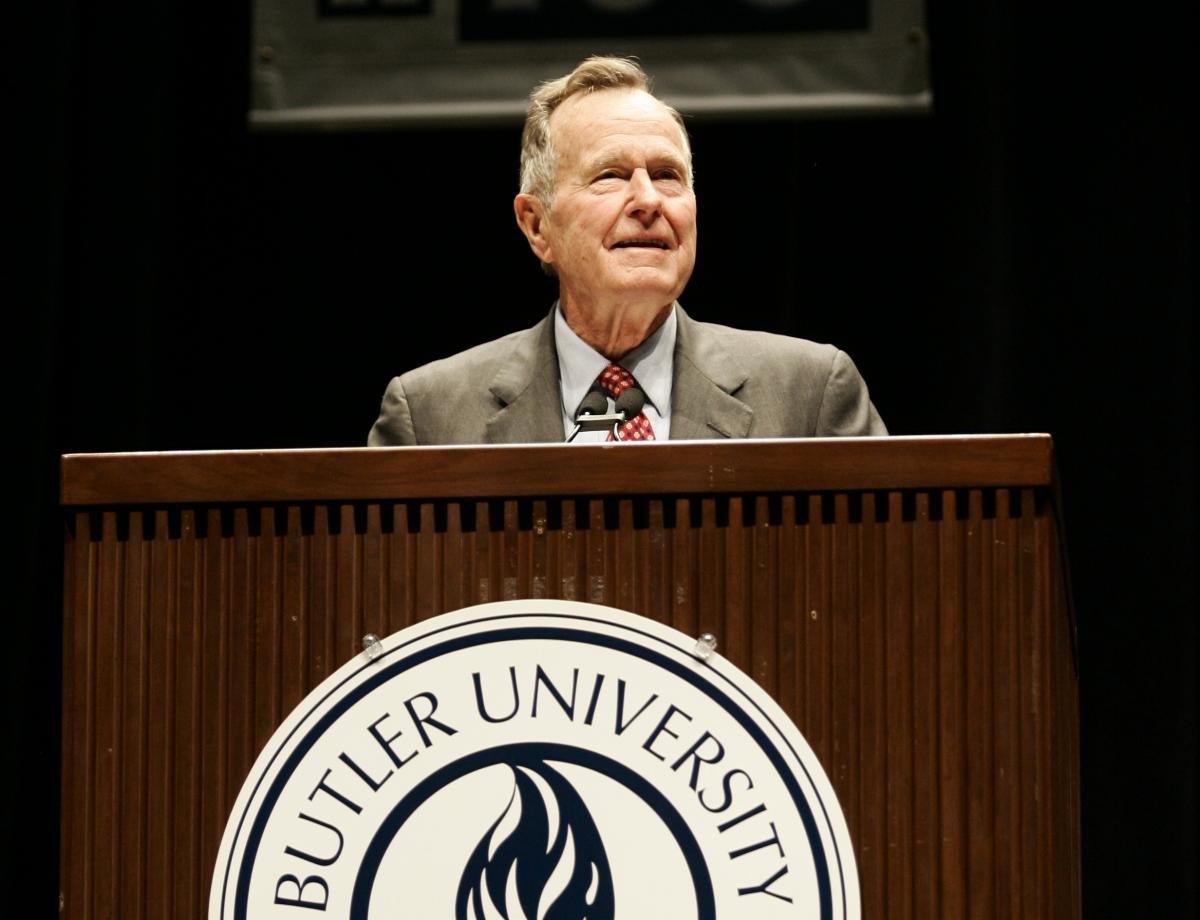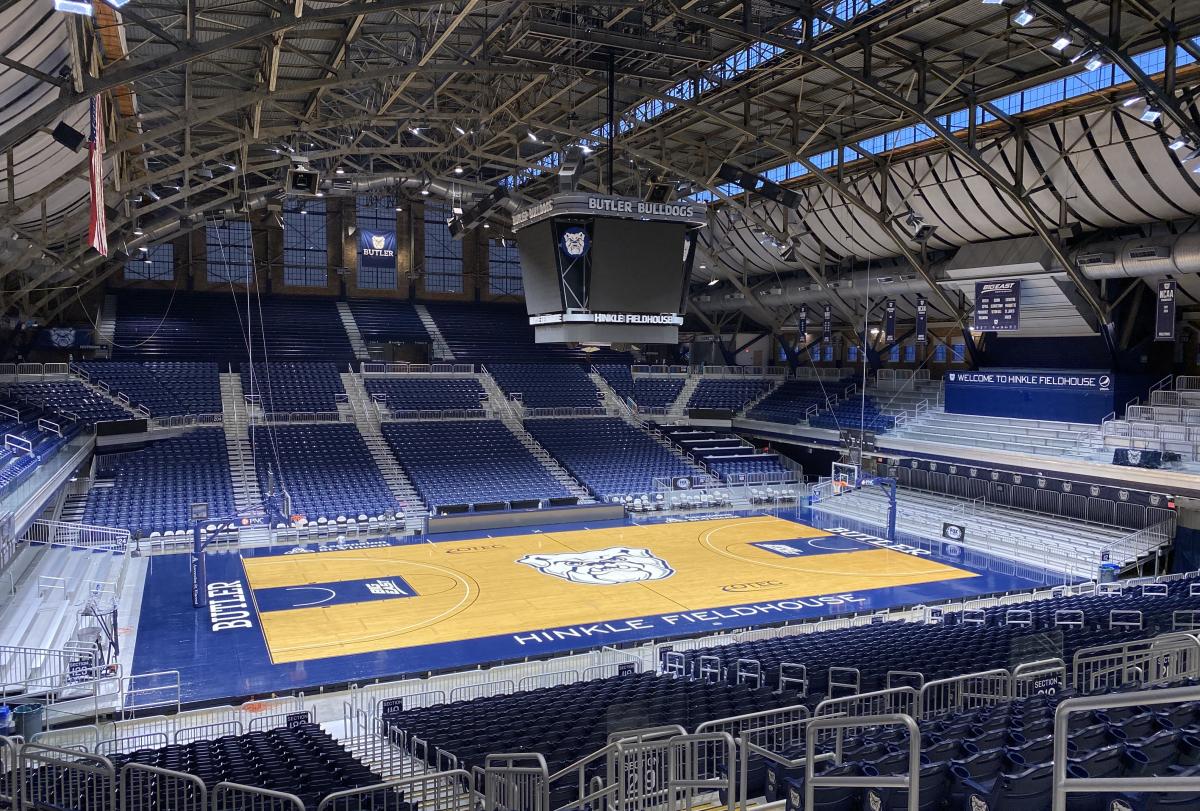Hinkle Fieldhouse is one of six Indiana venues proudly serving as a host site for the 2021 NCAA Division I Men’s Basketball Championship. Affectionately known as “Indiana’s Basketball Cathedral,” Hinkle Fieldhouse has played host to many memorable basketball games, community events, and notable public figures during its illustrious 93-year history. The construction and upkeep of this National Historic Landmark has been made possible by a long line of generous and visionary philanthropists who hoped this building would be a gift to the Central Indiana community.
1928: Hinkle Fieldhouse, originally known as Butler Fieldhouse, was built and financed by the philanthropic contributions of a corporation of 41 Indianapolis businessmen. With a seating capacity of 15,000 at the time of its opening, it was the largest basketball arena in the country, a distinction it held for 20 years.

March 7, 1928: Butler played its first basketball game in the Fieldhouse on March 7, 1928, defeating Notre Dame 21-13, in overtime, before 12,000 fans. Since the Fieldhouse was not entirely completed at the time, the building dedication was held at a later date. Completion of the Fieldhouse was guaranteed when Butler signed a lease agreement with the Indiana High School Athletic Association, which allowed the high school state tournament to be played in the new facility.
December 21, 1928: The Fieldhouse was officially dedicated at a game against Purdue University, which the Bulldogs won 28-27.
October 28, 1932: President Herbert Hoover delivered a speech to an estimated overflow standing-room only crowd of 23,000 at the Fieldhouse in his bid for re-election in the upcoming presidential race. The speech was broadcast to a national radio audience. Hoover lost the November 8 election to Franklin D. Roosevelt.
1933: The removable hardwood basketball court, which originally ran east–west, was changed to a north–south orientation to provide additional arena seating and to keep the sunlight, which streamed in from the large west-facing upper windows, out of the players’ eyes.

March 1935: Future Olympic Gold Medalist Jesse Owens ran 60 yards in 6.09 seconds during the Butler Relays intercollegiate event, tying a world record. He had to crash into an improvised barrier of hay bales to prevent his momentum from carrying him into the stands.

May 3, 1936: To open National Music Week, Sigma Alpha Iota, the national professional music sorority, sponsored a grand piano recital. 125 pianos were brought to the Fieldhouse, where 825 pianists played a variety of songs and accompanied the combined choirs of Butler University and the Arthur Jordan Conservatory of Music. Admission was 50 cents, and proceeds were used to aid the sorority’s scholarship and student loan funds. Approximately 25,000 spectators attended the recital over two performances.
February 1937: The Fieldhouse hosted a six-day bicycle race that lasted for 11 hours and 45 minutes each day. Riders rested in bunks arranged in the infield of the track between races, and approximately 30,000 spectators attended over the course of the six-day race.

March 1937: Fred Perry defeated Ellsworth Vines in a three-set tennis match in the Fieldhouse.
March 1938: Elephants, ponies, and horses paraded through the Fieldhouse during the Shriner’s Indoor Circus, which also included a trapeze and high wire act.
March 1940: Butler hosted the 1940 Eastern Regional of the NCAA basketball tournament, which featured Indiana, Duquesne, Western Kentucky, and Springfield. Indiana won the Regional, advancing to the finals in Kansas City. This was the only other time Butler has hosted NCAA Men’s Basketball Championship tournament games.
1943-45: The Fieldhouse was utilized as U.S. Army and Navy barracks during World War II. Sailors and Army Air Corps recruits were stationed in the Fieldhouse while attending training courses on campus. Sleeping quarters were constructed in the main gym, and a kitchen and mess hall were also installed.

October 1952: The Fieldhouse was transformed into an ice rink to host an ice show headlined by Sonja Henie and a cast of 200 ice skaters.
March 1954: The “Milan Miracle” occurred at the Fieldhouse when tiny Milan High School’s basketball team defeated the much larger Muncie Central High School in the state high school basketball championship. Milan’s Bobby Plump made the last-second shot to win the game and went on to become a star player at Butler. Two other players, Rollin Cutter and Ray Craft, also went on to play for Coach Hinkle, as had the Milan coach, Marvin Wood.
September 23, 1954: Then-Vice President Richard Nixon delivered a speech in the Fieldhouse for a GOP Rally event in the lead-up to midterm elections.
October 15, 1954: President Dwight D. Eisenhower gave a speech at the Fieldhouse about farm policy and the state of agriculture.
March 1955, 1956: The Crispus Attucks High School basketball team, led by Oscar Robertson, became the first all-Black team in the nation to win a state championship in an integrated tournament. The team defeated Roosevelt High School 97-64 in the Fieldhouse, and went undefeated the following year to win a second consecutive title.

October 1959: Evangelist Billy Graham visited Hinkle Fieldhouse and delivered a speech to students. Afterward, he visited with students and faculty of the nearby Christian Theological Seminary.
November 1965: The Butler Board of Trustees voted to change the name of the facility from Butler Fieldhouse to Hinkle Fieldhouse in honor of Butler’s legendary coach and athletic director Paul D. “Tony” Hinkle, who contributed to the University’s athletic success for nearly 50 years. Hinkle is also known for originating the orange basketball. Until the late 1950s basketballs were dark brown. Hinkle worked with the Spalding Company to create an orange version that was more visible to players and fans. It was formally adopted by the NCAA after a trial use at the 1958 Final Four.

January 9, 1968: Hinkle Fieldhouse hosted the inaugural American Basketball Association (ABA) All-Star Game. Larry Brown, who would later become Head Coach of the Indiana Pacers from 1993-1997, was named the game’s MVP.
1975-76: The inaugural season for the Butler Women’s Basketball program took place in 1975-76 with the team’s home games being played at Hinkle Fieldhouse. Hinkle Fieldhouse also hosted the first girl’s high school state basketball championship in March 1976.
April 22, 1976: President Gerald Ford spoke at Hinkle Fieldhouse before a crowd of approximately 15,000 as part of the Butler University Student Assembly Lecture Series while fending off a Republican primary challenge from Ronald Reagan.
1986: The final scenes of the movie Hoosiers, loosely based on the 1954 “Milan Miracle” state championship, were filmed at Hinkle Fieldhouse.

1987: The Fieldhouse was declared a National Historic Landmark.
August 1987: Hinkle Fieldhouse served as the volleyball host venue for the 1987 Pan American Games. The United States defeated Cuba in the men’s gold medal match before an estimated crowd of 15,000.
1989: Renovations reduced the Hinkle Fieldhouse seating capacity from 15,000 to 11,000.
November 28, 1993: Under then-Head Coach and current Director of Athletics Barry Collier, Butler defeated Bobby Knight’s No. 11 Indiana Hoosiers 75-71, the team’s first victory over the Hoosiers since 1958. Many consider the win to be a turning point in Butler basketball history.
March 1, 2003: Avery Sheets hit a three-point shot at the buzzer to beat Milwaukee for the Horizon League Championship and an automatic bid to the NCAA tournament, where the Bulldogs went on to achieve their first-ever appearance in the Sweet Sixteen.
November 6, 2005: Former President Bill Clinton spoke at Hinkle Fieldhouse.

March 2, 2006: Former President George H.W. Bush spoke at Hinkle Fieldhouse. Both former presidents spoke as part of Butler’s Sesquicentennial Celebration of Diversity Distinguished Lecture Series.

May 6, 2008: Future President Barack Obama delivered a speech at Hinkle Fieldhouse while campaigning against his Future Secretary of State Hillary Clinton in that day’s Indiana Democratic primary election for President.
November 2011: Butler announced a $16 million fundraising campaign to preserve and update Hinkle Fieldhouse, “Indiana’s Basketball Cathedral.” The renovations included extensive exterior work, improved stadium accessibility, and upgraded areas for sports medicine, strength and conditioning, academics, locker rooms, and athletic department offices. Game day upgrades for fans included new chairback seating (reducing capacity to 9,100), a video scoreboard, and more concessions and restrooms.
January 19, 2013: Hinkle Fieldhouse hosted ESPN’s national College GameDay broadcast. Fans rushed the court after Roosevelt Jones hit the game-winning shot as Butler defeated Gonzaga 64-63.
2014: Butler surpassed its fundraising goal for the Campaign for Hinkle Fieldhouse, ultimately raising more than $17.1 million for improvements aimed to “Keep Hinkle, Hinkle.” In honor of the largest gift to the campaign, a $1 million gift from the Efroymson Family Fund, the practice gym was renamed the Efroymson Family Gym. Renovations were unveiled to the public in fall 2014.

April 2015: Hinkle Fieldhouse received the Cook Cup Award for Outstanding Restoration from Indiana Landmarks.
January 4, 2017: Butler defeated defending national champions Villanova 66-58. It was the first time the Bulldogs beat a No. 1 team at home.
October 2018: Butler University announced a second phase of renovations to Hinkle Fieldhouse. Donors collectively gave more than $10.6 million to fund updates including the installation of air conditioning for all public areas of the Fieldhouse, extensive work to the men’s soccer locker room, and a complete renovation of the Efroymson Family Gym.
March 2021: Hinkle Fieldhouse serves as one of the host sites of the 2021 NCAA Division I Men’s Basketball Tournament, held entirely within the state of Indiana.



